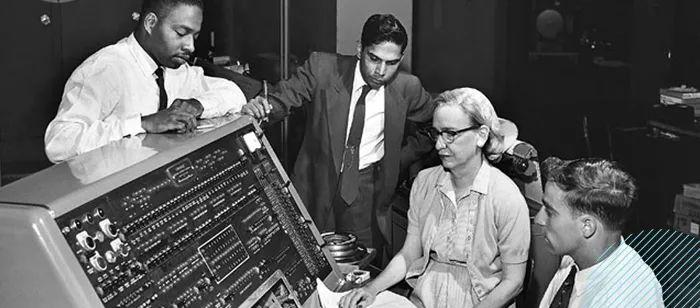
Reporting by XinZhiyuan
Edit: David
COBOL language has been born for more than 60 years, and today there are still 800 billion lines of code running in the world, why is its vitality so strong that it is not "retired"?
Data shows that a 60-year-old programming language supports far more applications that are mastered by fewer and fewer developers than previously thought.
The language is called COBOL.
According to a report by IT modernization firm Micro Focus, more than 800 billion lines of COBOL code are currently used worldwide every day, about three times what was expected.
What's more, almost half of the developers surveyed actually expect the number of COBOL in their organizations to increase over the next 12 months, while a similar percentage say they expect COBOL applications to exist for at least another decade.
The "COBOL Problem" brought by the new crown
A typical narrative around the COBOL language is that the reduction in the number of developers familiar with the language can lead to serious problems because it offers a wide variety of mission-critical applications in government and banking sectors.
For example, in the early days of the coronavirus pandemic, the ancient programming language made headlines. According to CNN, in the face of the epidemic, the US state governments have said that there is a serious shortage of COBOL programmers.
New Jersey Gov. Phil Murphy called on volunteers to master how to use the decades-old computer programming language because many of the state's systems are still running on older mainframes, and the underlying support is COBOL.
With 362,000 residents filing for unemployment, the state's 40-year-old mainframe was once overwhelmed by a lack of qualified operations personnel.
Currently, COBOL is used in the U.S. Department of Homeland Security and Department of Veterans Affairs systems, which automatically provides time and attendance for employees, timekeepers, payroll, and supervisors; can track claims for benefits, eligibility, and date of death made by veterans;
Department of Homeland Security's systems track current and previous hiring plans and maintain information about hired positions and individuals.
In 2019, 64 percent of mainframe-driven organizations plan to run more than half of their mission-critical on the platform, up from 57 percent in 2018.
A 2017 Reuters report showed that 220 billion lines of COBOL code are still in use today, and 43 percent of banking systems and 95 percent of ATM swipe devices still rely on this ancient computer programming language.
In terms of the average age of COBOL developers, most programmers are in the 45-55 age group, which can be said to be almost "uncle-level".
How was COBOL born in his 60s?
CoBOL (Common Business-Orientated Language) was born in the 1950s, is the earliest high-level programming language, and one of the world's first computer languages to implement standardization, is a kind of compiled language.
Computer scientist Grace Hopper is directing a team that developed early COBOL applications
Designed for specific purposes, COBOL was originally created as part of the U.S. Department of Defense's assisted data processing program and was later pushed by computer manufacturers to promote its widespread adoption. Since then, its readability, simplicity, and repeatability have made it an integral part of programmers.
Like English, COBOL has a certain degree of universality. We actually use COBOL every day, and whether we know it or not, it continues to affect our lives. Banking, insurance, logistics, retail, government, arguably almost any time, we're dealing with COBOL applications.
Like English, COBOL is constantly iteratively updating to meet new needs and support new technologies, and today it still supports everything from old-fashioned batch tasks to the back-office of modern mobile apps.
Many large enterprises still use fluent COBOL, a language that excels at performing large-scale batch and transactional operations on the mainframe. Reuters pointed out that the banking industry is one of the most favored industries for COBOL, and the importance of this is self-evident in the financial industry, where the volume of daily business handled by the COBOL system is estimated to reach $3 trillion.
In addition, THERE is COBOL behind deposit accounts, card networks, ATMs, mortgage services, loan classification and bookkeeping services.
At present, although COBOL is essentially obsolete among the new generation of developers, many enterprises do not intend to abandon the language.
According to market research firm MicroFocus, the majority of companies that rely on COBOL (64%) prefer to modernize their applications rather than rewrite and replace them in other languages.
Meanwhile, 92 percent of respondents said COBOL continues to be strategically important to their business.
Why are ancient programming languages still in use today?
Someone asked on Quora: Why is it that the ancient programming language that was used for 50-60 years is still widely used today?
A veteran programmer who claims to have 25 years of programming experience said that the earliest programmers are experts and have a high degree of mastery of the characteristics of hardware and software systems. And "the reason for the long-term stability of a piece of software is the expertise of the software developers involved in designing, developing, maintaining, and testing it."
Others say that decades later, the cost of completely replacing and rewriting the entire system is too high. Since the old system is still working, it is better to continue to maintain it.
Another important reason is that the writers of COBOL's early programs and applications at that time were familiar with the specific use of COBOL systems, and most of the financial, banking, insurance and other systems that widely used COBOL did not require the high iteration speed of other industries, and lacked the motivation to turn over.
In the words of Ed Airey, Director of CoBOL Product Marketing at Micro Focus, "The large amount of COBOL application code on the market brings tremendous value to the organization and requires continuous investment as part of a larger modernization strategy." For IT leaders supporting core business systems, the modernization of COBOL applications is at the heart of digital transformation."
Resources:
https://www.techradar.com/news/this-ancient-programming-language-is-way-more-common-than-we-all-thought
https://www.quora.com/Why-are-banks-still-using-COBOL-Is-it-because-the-cost-of-switching-is-so-high
https://www.cnbc.com/2020/04/06/new-jersey-seeks-cobol-programmers-to-fix-unemployment-system.html